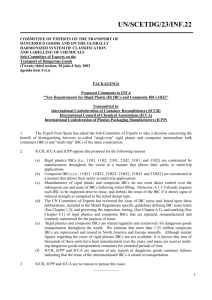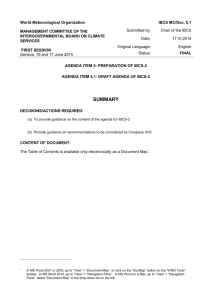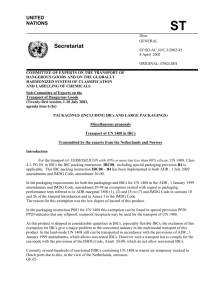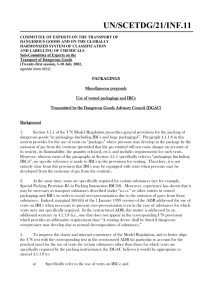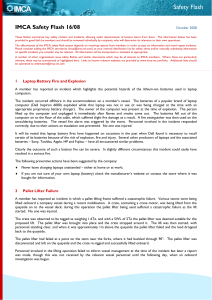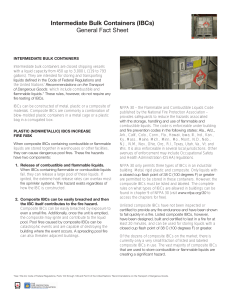2014 FPPWE keynote slides
advertisement
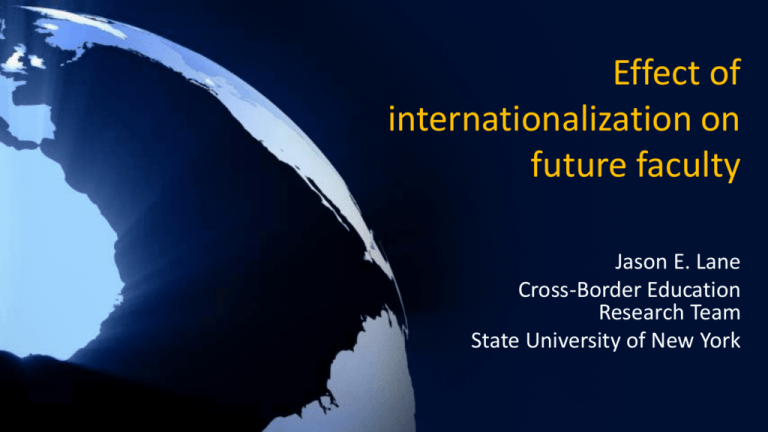
Effect of internationalization on future faculty Jason E. Lane Cross-Border Education Research Team State University of New York Outline • Overview of cross border higher education • The internationalization of research efforts • Development of international branch campuses Cross-border higher education • Internationalisation / Globalisation • Cross-border mobility: – – – – – Students Academics Programmes Institutions Projects (research, etc.) Student mobility International Students Worldwide, Selected Years International enrollment as a percentage of total higher education enrollment for top countries, 2011/2012 Top 8 host countries of globally mobile students A view from the US: international students • In 2012-2013, the number of international students in the US increased 7.2% to a record high of 819,644 • The top senders of international students are China, India, and South Korea. • International students comprise about 3% of undergrads and 15% of grads • CA, NY, and TX are the top hosting states A view from the US: study abroad • In 2012-2013, the number of students studying abroad reached 283,332 and increase of 3.4% • The top destinations are UK, Italy, Spain, France, and China. • Top fields are social sciences, business, and humanities • 58% go for eight weeks or less Programme and institution mobility International mobility of programs and institutions • Educational programme and institution mobility is still limited in scale but grows rapidly, especially in the Asia-Pacific region – About 300,000 students enrolled in UK and Australian foreign programmes – 30% of all international students enrolled in Australian institutions studied from their country in 2007 (against 24% in 1996 and 37% in 2001); all Australian universities engaged in cross-border operations – Singapore: more undergraduate students accessed a foreign programme from Singapore than studied abroad in 2000 – China: 9-fold increase in foreign programmes between 1995 and 2004: 831 joint schools (126) and programmes (705) Examples of exporters • Australia – Monash, RMIT • UK – Liverpool (China), Nottingham (Malaysia, China), New Castle (Malaysia) • US – Apollo, Laureate – NYU, Carnegie Mellon, MIT, etc. • Germany – German University in Egypt • France – Sorbonne (Abu Dhabi), Egypt • Sweden – Karolinska Institute (China) Examples of importers • United Arab Emirates – Knowledge village, DIAC • Qatar – Education city • Korea – IFEZ: global academic cluster (2005-2010) • Malaysia – Kuala Lumpur Education City – Iskandar Example: Singapore Branch campuses Partnerships • • • • • • • • • INSEAD University of Chicago Graduate School of Business Duke ESSEC SP Jain Centre of Management Digipen Institute of Technology University of Nevada, Las Vegas (UNLV) • • • • • • • • • Georgia Institute of Technology Massachusetts Institute of Technology (MIT) The Wharton School of the University of Pennsylvania Design Technology Institute German Institute of Science & Technology Shanghai Jiao Tong University Stanford University Waseda University Indian Institute of Technology, Bombay New York University School of Law Cornell University A variety of models A variety of arrangements and objectives • Multiplication of commercial arrangements in Asia – but noncommercial academic partnerships remain the norm in Europe • Public (or private not-for-profit) institutions have been the main drivers of commercial programme and institution mobility • A multiplicity of business models – – – – Partnerships: franchise, twinning arrangement Branch campuses, multi-campus institutions Buying foreign institutions Invited or not by country Drivers, rationales, strategies Rationales and drivers of crossborder higher education • Decrease in travel and communication costs • Globalisation, migration and labour market opportunities • More demand from students and their families (and unmet demand in some emerging countries) • Policies at country and/or regional level • Source of funding for educational institutions and economic strategy for some countries • Institutional strategies for prestige Some challenges • Quality and recognition, hence the Guidelines But also: • Equity of access and financing • Brain drain • Decrease of aid to developing countries • Culture and language • Reaping the benefits Research Collaborations Vital Statistics – Unstoppable Trends Spent on Research and Development US $ Numbers of researchers Number of publications % GDP 2007 1145 B 1.7 7.1 M 1.6 M 2002 790 B 1.7 4.7 M 1.1 M Since the beginning of the 21st Century, global spend has almost doubled US, Japan, Europe, Australasia all increased spending by roughly one-third China, India and Brazil more than doubled expenditure Architecture of world science undergoing transformation, with global networks, mostly self-organized (exceptions, human genome, CERN, etc.) US still leads the world, with 20% of world authorship US, Japan, UK Germany, and France together command 59% China now second highest producer India has displaced Russia in top ten Some Major Global Societal Issues (A. Leshner: Building a Global Science Community, Nov 2011) • Sustainability • Renewable energy • Information and communications technology • Universal access to education • Poverty and economic opportunity • Technology-based manufacturing and jobs • • • • Intellectual property rights Terrorism and security Disasters Science and Technology Capacity-Building • Vaccines and medical therapies • Quality and accessibility of Health Care Proportion of Global Publications, by Country Source: Elsevier Scopus, Royal Society umber of Collaborative Papers Internationally Collaborative Papers (2008) Source: Royal Society United States (2008) 80,000 60,000 United States (1996) 40,000 China 20,000 0.15 UK Germany France Switzerland Japan China 1996 0.2 0.25 0.3 0.35 0.4 0.45 0.5 0.55 Collaborative Papers as a proportion of national output 0.6 Other Forcing Functions • Qatar Foundation has $1.2B available annually to aid the transition from a carbon to a knowledge economy • Turkey’s investments have grown rapidly • Chile has opened its doors to international expertise through its Millennium Institutes • Singapore seeks to become a regional hub • India’s 5-year plan includes the establishment of 30 new central universities • Sao Paulo funds approximately 30% of Brazil’s R&D Country Goals • • • • • • China – seeks to increase R&D to 2.5% of GDP by 2020 Brazil: 2.5% by 2022 South Korea: 5% by 2022 EU: Lisbon goal of 3% USA: goal of 3% Japan: well above 3% “The days of overwhelming U.S. science dominance are over, but the country can actually benefit by learning to tap and build on the expanding wellspring of knowledge being generated in many countries.” The Shifting Landscape of Science, Caroline S. Wagner, Issues Online in S&T, NRC, 2011 Who is Collaborating with Whom? What about the developing world? Most of Africa’s collaboration is with the G20 countries, but South-South collaboration is a growing trend, the the US could amplify. Egypt and Sudan – important bridges Kenya and South Africa- important hubs Foreign Higher Education Outposts Cross-Border Education Research Team online resources www.globalhighered.org • Up-to-date list of IBCs and Ed. Hubs • Annotated bibliography on IBCs • Updates on our activities/publications http://www.bc.edu/research/cihe/cbhe/ • Partnership with CIHE at Boston College • Hub for research/writings on CBHE • Blogs on Chronicle of HE & Inside HE Parsons goes to Paris (1920s) Johns Hopkins opens in Italy Florida State heads to Panama Today Not just a US phenomenon Founding Date of IBC International Branch Campuses • Blue: Home Campus Red: Branch Campus Webster University New York University The myths • • • • • • • IBCs focus only on teaching They are “hollow shells” All IBCS are subsidized by governments IBCs are revenue producing entities IBCS move North to South Extreme form of privatization IBCs are part of a bubble 7 Myths “Truths” • • • • • • • Many IBCs have multifaceted missions Many now offer co-curricular experiences They rarely prove to be profitable in the short term Not all are gov’t subsidized IBCs move in all directions Some IBCs fulfill public goals IBC population is stabilizing Curriculum Offerings Public-Private (home campus) What is the motivation? Home country • None • Diplomacy • Economic Host country • • • • Leap Frogging Capacity Bldg. Diplomacy Economic Institution • • • • Prestige Economic Market Share Educational Issues to Consider • Institutionally Driven (vs. faculty driven) • Quality Assurance (internal and external) • Role in the foreign country? – Access, Research, Community Engagement? • Balancing Standardization vs. Diversification • A shift in the definition of students (what does “international” mean?) • Culture clashes (e.g. academic freedom, religion, etc.)


